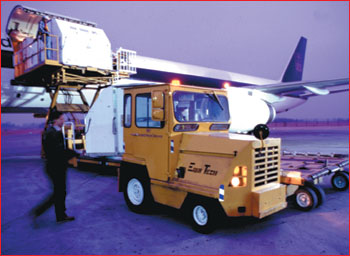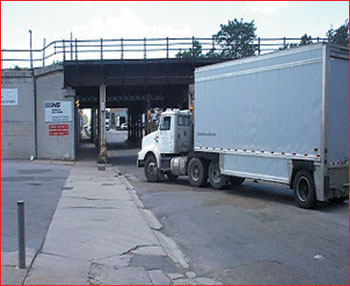Key Freight Transportation Challenges
Financing
In the past, investments in Interstate highway construction, Class I railroad improvements, port terminals, and other transportation investments have more than adequately met the needs of moving freight. Now, neither the public sector nor the private sector alone has the resources to invest in improvements to meet projected future growth. Both sectors must now look for opportunities for joint financing.
But it is not just a matter of more money. Funding needs to be directed to the right types of investments in the right places if transportation productivity is to be maximized. These two elements of freight financing—funding level and project type/location—must be carefully considered in order to ensure the efficiency and reliability of the freight transportation system in the early years of the 21st Century.

Air cargo was the fastest growing segment of the freight industry
in the 1990s.
Source: American Trucking Associations Foundation
The type or mix of options used to finance freight improvements varies among modes. Highways, for example, are usually built using public money from federal and state sources. Ports are funded with public and private funds, port revenue, and revenue bonds. Railroads are usually funded privately, although public money has been used to improve safety at highway-rail grade crossings and for smaller railroads, especially when there is a risk of a railroad being abandoned. Passenger fees and the jet-fuel tax typically support airport facilities, although public-private partnerships between airport authorities and airfreight integrators have allowed for the issuance of revenue bonds to develop cargo facilities.
Public funding for freight infrastructure may be difficult to secure if projects are thought to have only private benefits limited to local jurisdictions. Not surprisingly, objections are often raised about public finance of projects when one company or one mode is perceived by others to benefit disproportionately. Moreover, with respect to highway and rail, passenger projects tend to be given a higher priority over freight projects in the state and local decisionmaking processes. Under current federal law, funding decisions are made at these levels of government, and freight interests are often not included in the planning process.
In some circumstances, private financing may also be difficult or expensive to arrange. Freight improvements must compete for bank loans with other types of projects, such as building warehouses and office buildings. Railroads and trucking companies have had difficulty finding lenders to finance improvements, or they are offered unfavorable rates over periods too short to cover the needs for long-lived assets, such as railroad track. This situation is compounded by the marginal economic health of some smaller railroads that may need grants, not loans, to maintain important parts of the rail system (USDOT FHWA 2000a).
The increasingly intermodal nature of freight transportation has complicated funding as well. When a freight project is intermodal, such as a road connecting a marine terminal with the Interstate system, it is often unclear who should initiate and fund the project. These issues become even more problematic when a project involves freight infrastructure on the borders with Canada and Mexico.

Intermodal
connectors are critical components of the Nation's freight system, tying modes
together and facilitating distribution of products to users. This connector in
the Chicago area is showing signs of wear and tear.
Source: FHWA
The Transportation Equity Act of the 21st Century (TEA-21) formally recognized the need to link intermodal freight needs to infrastructure investments and advocated new investment schemes. The Transportation Infrastructure Finance and Innovation Act (TIFIA), which was launched by TEA-21, provides a new source of financing underwritten by a dedicated user revenue stream. However, TIFIA limits state and local discretion in the types of projects that may receive Federal-Aid highway funding. For example, current eligibility requirements do not allow public funds to be used for private facility improvements or railroad projects that are not connected to highways. Moreover, the minimum $100 million threshold for projects makes it more difficult to fund improvements of intermodal connectors, which are generally in worse condition that the National Highway System as a whole (USDOT FHWA 2000b). Freight stakeholders suggest that selective modifications to TIFIA could enhance its use for freight projects.
Similarly, the Railroad Rehabilitation and Improvement Financing (RRIF) credit program was created under TEA-21 to help railroad finance capital improvements, particularly those that assist smaller short line and regional railroads. Unfortunately, the RRIF's implementation, to date, has been hampered by the lack of federal funding, limited awards, and strict applicant requirements, including mandated documentation that the RRIF is indeed the funding source of "last resort" for the applying railroad.
One of the most flexible programs, the Congestion Mitigation and Air Quality Improvement Program (CMAQ), which was established under the Intermodal Surface Transportation Efficiency Act, has been most successful in funding a variety of freight transportation projects, some of which are privately owned. CMAQ-funding, however, has limitations, as it must be built around the requirement of reducing the release of harmful emissions from transportation. Projects are also limited to nonattainment areas.
Many states, local jurisdictions, and port authorities are initiating new financing efforts to advance freight projects. The Alameda Corridor, the FAST Corridor in Washington State, rail improvements in Chicago, the MAROPS program, and others reflect the widely held view that freight transportation is important.
Given expectations of future demand, however, current funding for freight infrastructure is clearly inadequate, especially for intermodal connectors, rail facilities, ports, multistate projects, and international gateways. Identifying ways to finance needed projects is critical to maintaining U.S. competitiveness in the global marketplace.
previous | next